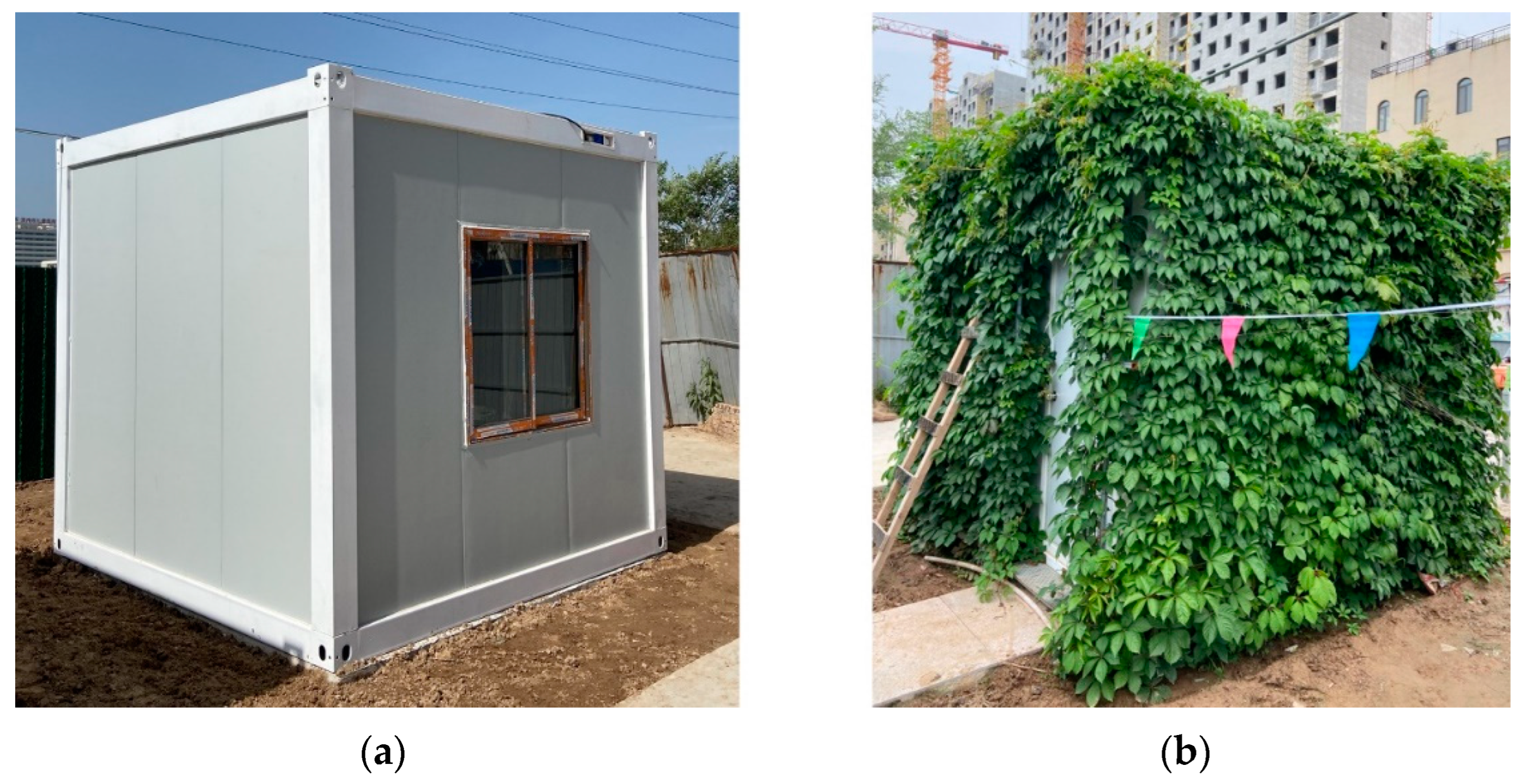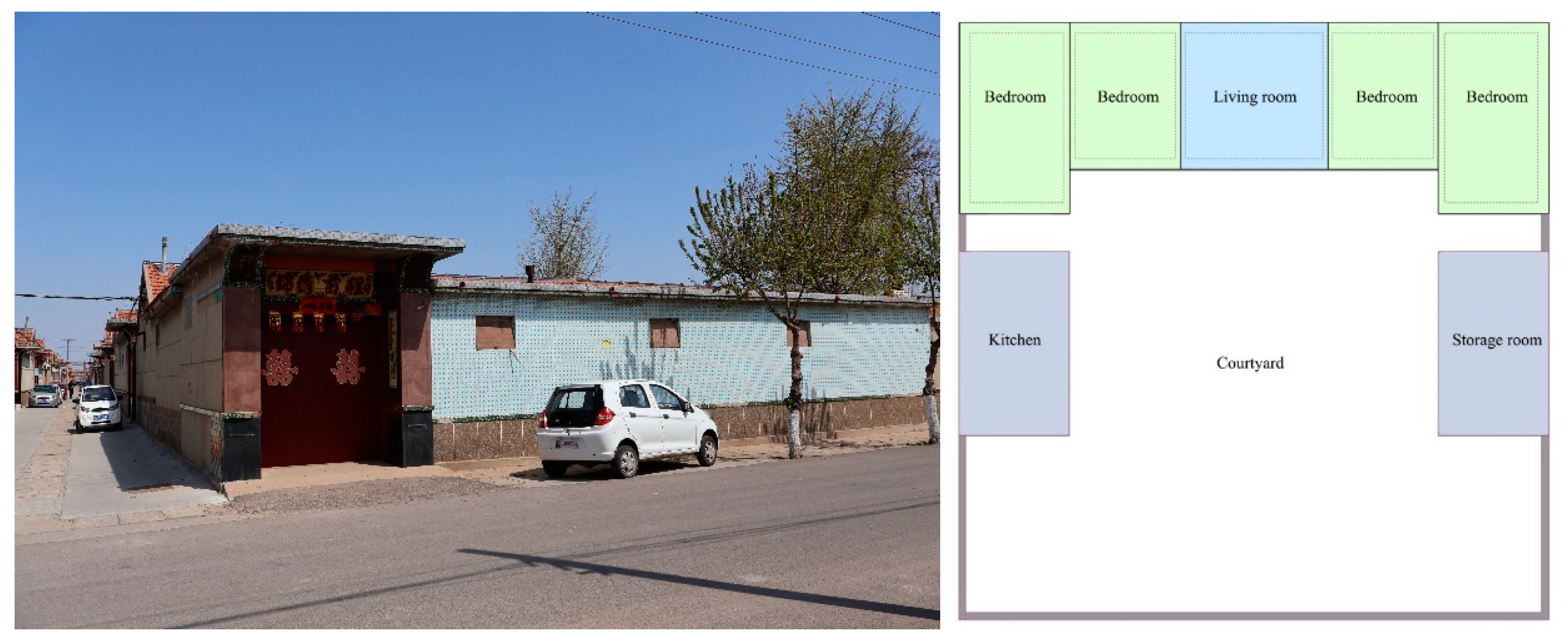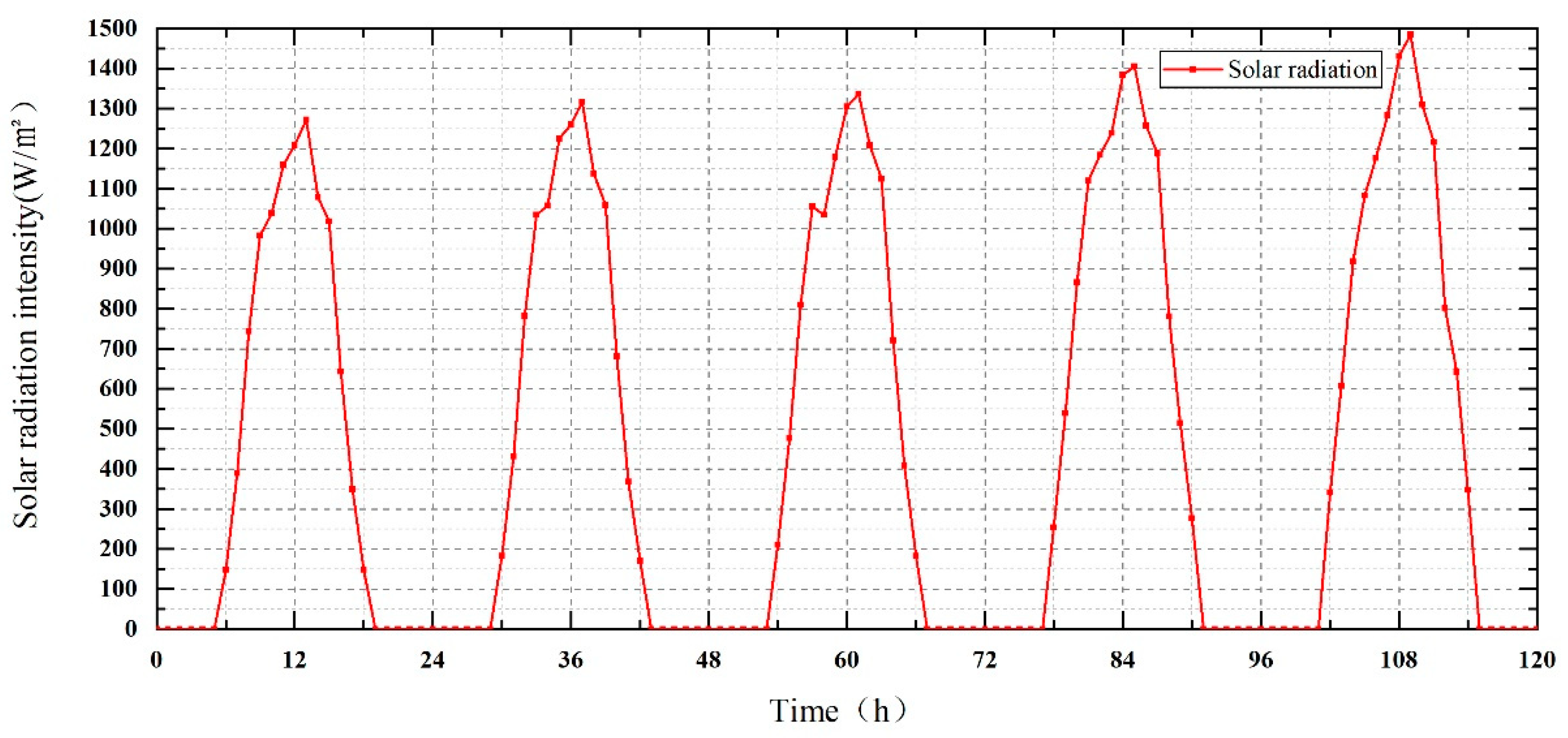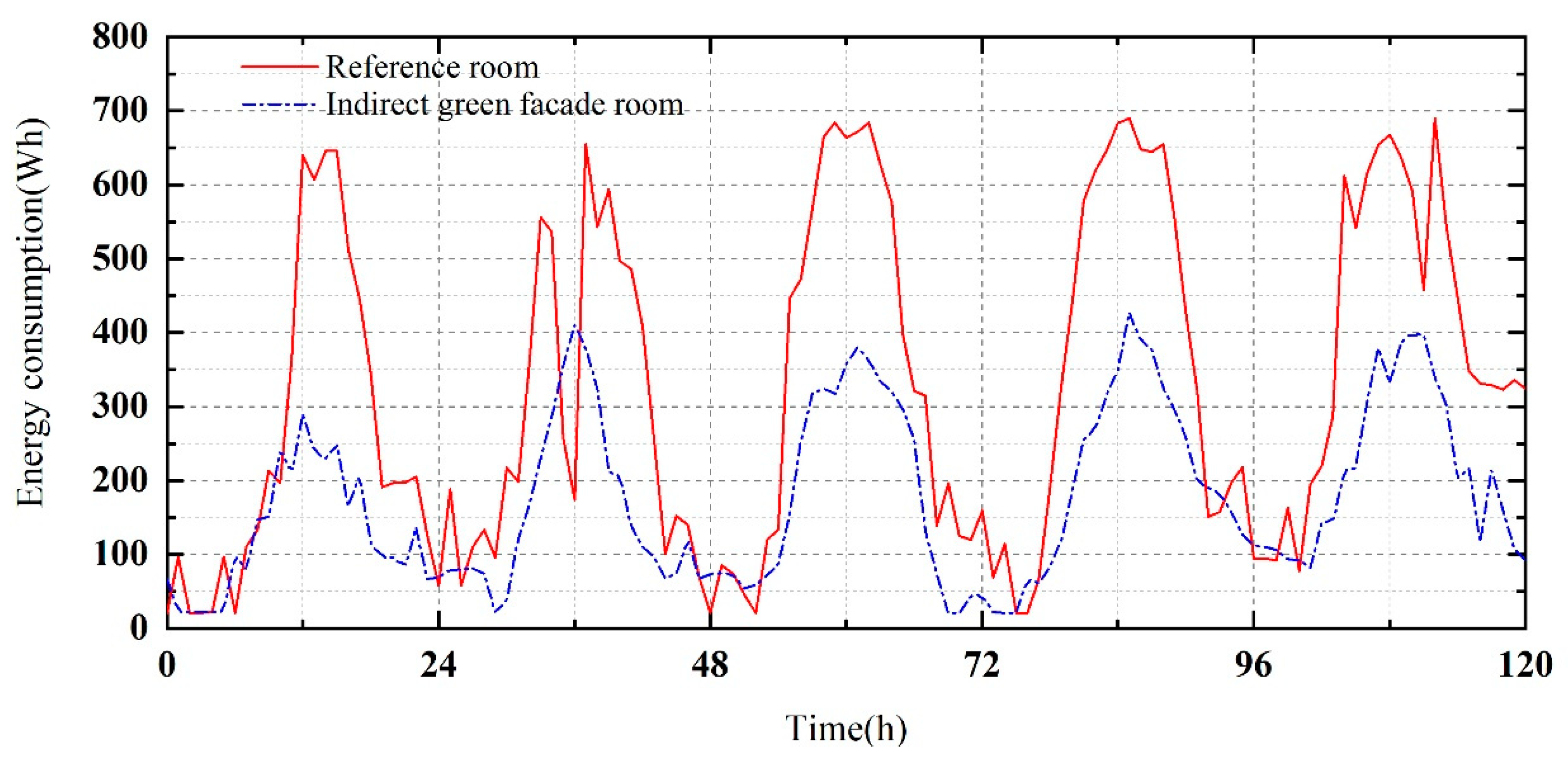Experiment and Simulation-Based Study of Energy Efficiency of Green Façade Retrofit of Existing Buildings in Rural Northern China †
Abstract
1. Introduction
2. Methods
2.1. Experimental Setup
2.2. Simulation Setup
2.2.1. Reliability Verification of Designbuilder
2.2.2. Energy Consumption Simulation of Typical Building
3. Results and Discussion
4. Conclusions
Author Contributions
Funding
Institutional Review Board Statement
Informed Consent Statement
Data Availability Statement
Conflicts of Interest
References
- Hoelscher, M.-T.; Nehls, T.; Jänicke, B.; Wessolek, G. Quantifying cooling effects of facade greening: Shading, transpiration and insulation. Energy Build. 2016, 114, 283–290. [Google Scholar] [CrossRef]
- Ismail, N.A.; Utaberta, N.; Yunos, M.Y.M.; Ismail, S. Malaysia going greens: A study on community commitment towards a greener urban living environment. Adv. Environ. Biol. 2015, 9, 498–503. [Google Scholar]
- Ip, K.; Lam, M.; Miller, A. Shading performance of a vertical deciduous climbing plant canopy. Build. Environ. 2010, 45, 81–88. [Google Scholar] [CrossRef]
- Blanco, I.; Convertino, F.; Schettini, E.; Vox, G. Energy analysis of a green façade in summer: An experimental test in Mediterranean climate conditions. Energy Build. 2021, 245, 111076. [Google Scholar] [CrossRef]
- Perini, K.; Ottelé, M.; Fraaij, A.; Haas, E.; Raiteri, R. Vertical greening systems and the effect on air flow and temperature on the building envelope. Build. Environ. 2011, 46, 2287–2294. [Google Scholar] [CrossRef]
- Karimi, K.; Farrokhzad, M.; Roshan, G.; Aghdasi, M. Evaluation of effects of a green wall as a sustainable approach on reducing energy use in temperate and humid areas. Energy Build. 2022, 262, 112014. [Google Scholar] [CrossRef]
- Xing, Q.; Hao, X.; Lin, Y.; Tan, H.; Yang, K. Experimental Investigation on the Thermal Performance of a Vertical Greening System with Green Roof in Wet and Cold Climates during Winter. Energy Build. 2019, 183, 105–117. [Google Scholar] [CrossRef]
- Viecco, M.; Jorquera, H.; Sharma, A.; Bustamante, W.; Fernando, H.J.; Vera, S. Green roofs and green walls layouts for improved urban air quality by mitigating particulate matter. Build. Environ. 2021, 204, 108120. [Google Scholar] [CrossRef]
- Weerakkody, U.; Dover, J.W.; Mitchell, P.; Reiling, K. Particulate matter pollution capture by leaves of seventeen living wall species with special reference to rail-traffic at a metropolitan station. Urban For. Urban Green. 2017, 27, 173–186. [Google Scholar] [CrossRef]
- Pérez, G.; Coma, J.; Barreneche, C.; de Gracia, A.; Urrestarazu, M.; Burés, S.; Cabeza, L.F. Acoustic insulation capacity of Vertical Greenery Systems for buildings. Appl. Acoust. 2016, 110, 218–226. [Google Scholar] [CrossRef]
- Wong, N.H.; Tan, A.Y.K.; Tan, P.Y.; Chiang, K.; Wong, N.C. Acoustics evaluation of vertical greenery systems for building walls. Build. Environ. 2010, 45, 411–420. [Google Scholar] [CrossRef]
- Madre, F.; Clergeau, P.; Machon, N.; Vergnes, A. Building biodiversity: Vegetated façades as habitats for spider and beetle assemblages. Glob. Ecol. Conserv. 2015, 3, 222–233. [Google Scholar] [CrossRef]
- Chiquet, C.; Dover, J.W.; Mitchell, P. Birds and the urban environment: The value of green walls. Urban Ecosyst. 2013, 16, 453–462. [Google Scholar] [CrossRef]
- Magliocco, A.; Perini, K. The perception of green integrated into architecture: Installation of a green facade in Genoa, Italy. AIMS Environ. Sci. 2015, 2, 899–909. [Google Scholar] [CrossRef]
- Wong, N.H.; Tan, A.Y.K.; Tan, P.Y.; Sia, A.; Wong, N.C. Perception studies of vertical greenery systems in Singapore. J. Urban Plan. Dev. 2010, 136, 330–338. [Google Scholar] [CrossRef]
- Tan, H.; Hao, X.; Long, P.; Xing, Q.; Lin, Y.; Hu, J. Building envelope integrated green plants for energy saving. Energy Explor. Exploit. 2020, 38, 222–234. [Google Scholar] [CrossRef]
- Coma, J.; Pérez, G.; de Gracia, A.; Burés, S.; Urrestarazu, M.; Cabeza, L.F. Vertical greenery systems for energy savings in buildings: A comparative study between green walls and green facades. Build. Environ. 2017, 111, 228–237. [Google Scholar] [CrossRef]
- Pérez, G.; Coma, J.; Chàfer, M.; Cabeza, L.F. Seasonal influence of leaf area index (LAI) on the energy performance of a green facade. Build. Environ. 2022, 207, 108497. [Google Scholar] [CrossRef]
- Perini, K.; Bazzocchi, F.; Croci, L.; Magliocco, A.; Cattaneo, E. The use of vertical greening systems to reduce the energy demand for air conditioning. Field monitoring in Mediterranean climate. Energy Build. 2017, 143, 35–42. [Google Scholar] [CrossRef]
- Moghaddam, F.B.; Mir, J.M.F.; Yanguas, A.B.; Delgado, I.N.; Dominguez, E.R. Building Orientation in Green Facade Performance and Its Positive Effects on Urban Landscape Case Study: An Urban Block in Barcelona. Sustainability 2020, 12, 9273. [Google Scholar] [CrossRef]
- Li, Z.; Chow, D.H.; Yao, J.; Zheng, X.; Zhao, W. The effectiveness of adding horizontal greening and vertical greening to courtyard areas of existing buildings in the hot summer cold winter region of China: A case study for Ningbo. Energy Build. 2019, 196, 227–239. [Google Scholar] [CrossRef]
- Utaberta, N.; Asif, N. Mosques as emergency shelters in disaster prone regions. Pertanika J. Soc. Sci. Humanit. 2017, 25, 207–216. [Google Scholar]
- Hassan, M.H.; Othuman Mydin, M.A.; Utaberta, N. Study of rising dampness problem in housing area in Klang Valley, Malaysia. J. Teknol. 2015, 75, 113–119. [Google Scholar] [CrossRef]








| Projects | Structures | U-Value |
|---|---|---|
| External wall | Cement mortar (40 mm) + clay bricks (200 mm) + cement mortar (40 mm) + gypsum veneer (10 mm) | 1.898 W/m2·K |
| Internal wall | Gypsum veneer (10 mm) + cement mortar (20 mm) + clay bricks (200 mm) + clay bricks (20 mm) + gypsum veneer (10 mm) | 1.674 W/m2·K |
| Roof | Cement mortar (40 mm) + reinforced concrete (200 mm) + gypsum veneer (10 mm) | 3.108 W/m2·K |
| Window | Single-layer glass (6 mm) and wooden frames | 5.7 W/m2·K |
| Door | Wooden single-panel solid doors | 3 W/m2·K |
| Projects | Parameter Settings |
|---|---|
| Refrigeration setting temperature | 24 °C |
| Cooling period | 1 June to 31 August |
| Personnel density | 0.043 people/m2 |
| Room illumination | 150 lux |
| Equipment heat gain | 12 W/m2 |
| Projects | Parameter Settings |
|---|---|
| Height of plants (m) | 0.2 |
| Cavity thickness (m) | 0.2 |
| Leaf area index | 1.94 |
| Leaf reflectivity | 0.4 |
| Leaf emissivity | 0.8 |
| Minimum stomatal resistance (s/m) | 120 |
| Max volumetric moisture content at saturation | 0.5 |
| Min residual volumetric moisture content | 0.01 |
| Initial volumetric moisture content | 0.15 |
Disclaimer/Publisher’s Note: The statements, opinions and data contained in all publications are solely those of the individual author(s) and contributor(s) and not of MDPI and/or the editor(s). MDPI and/or the editor(s) disclaim responsibility for any injury to people or property resulting from any ideas, methods, instructions or products referred to in the content. |
© 2025 by the authors. Licensee MDPI, Basel, Switzerland. This article is an open access article distributed under the terms and conditions of the Creative Commons Attribution (CC BY) license (https://creativecommons.org/licenses/by/4.0/).
Share and Cite
Qi, S.; Utaberta, N.; Kiet, A.L.K. Experiment and Simulation-Based Study of Energy Efficiency of Green Façade Retrofit of Existing Buildings in Rural Northern China. Eng. Proc. 2025, 84, 93. https://doi.org/10.3390/engproc2025084093
Qi S, Utaberta N, Kiet ALK. Experiment and Simulation-Based Study of Energy Efficiency of Green Façade Retrofit of Existing Buildings in Rural Northern China. Engineering Proceedings. 2025; 84(1):93. https://doi.org/10.3390/engproc2025084093
Chicago/Turabian StyleQi, Sun, Nangkula Utaberta, and Allen Lau Khin Kiet. 2025. "Experiment and Simulation-Based Study of Energy Efficiency of Green Façade Retrofit of Existing Buildings in Rural Northern China" Engineering Proceedings 84, no. 1: 93. https://doi.org/10.3390/engproc2025084093
APA StyleQi, S., Utaberta, N., & Kiet, A. L. K. (2025). Experiment and Simulation-Based Study of Energy Efficiency of Green Façade Retrofit of Existing Buildings in Rural Northern China. Engineering Proceedings, 84(1), 93. https://doi.org/10.3390/engproc2025084093






